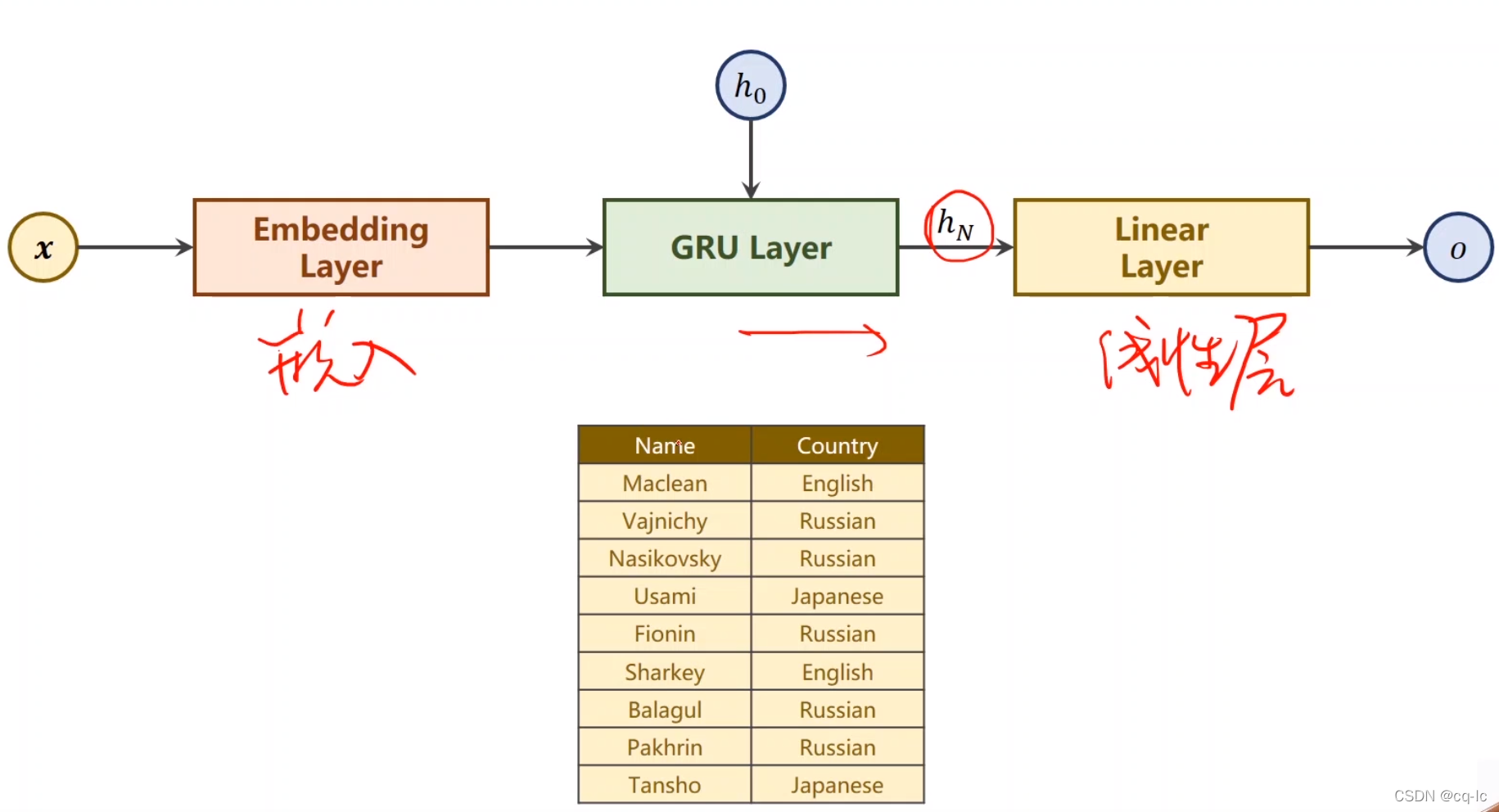B站 刘二大人:循环神经网络(高级篇)
目录
1、名字分类数据
????????数据准备:?

????????补零:

????????国家对照:

?
2、bi-directional双向循环神经网络

?????????反向传播计算一次。

?
3、pack_padded_sequence作用
????????堆叠未排序不可行:

????????先根据长度来排序:

?
4、代码实现名字分类
???代码如下:
import math
import matplotlib.pyplot as plt
import numpy as np
import torch
from torch.utils.data import Dataset
from torch.utils.data import DataLoader
import gzip
import csv
import time
HIDDEN_SIZE = 100
BATCH_SIZE = 256
N_LAYER = 2
N_EPOCHS = 50
N_CHARS = 128 # 这个是为了构造嵌入层
USE_GPU = False # 使用GPU会报错
class NameDataset(Dataset):
def __init__(self, is_train_set):
filename = './names_train.csv.gz' if is_train_set else './names_test.csv.gz'
with gzip.open(filename, 'rt') as f: # r表示只读,从文件头开始,t表示文本模式
reader = csv.reader(f)
rows = list(reader) # 读出名字和语言
self.names = [row[0] for row in rows]
self.len = len(self.names)
self.countries = [row[1] for row in rows]
self.country_list = list(sorted(set(self.countries))) # set变成集合,然后排序
self.country_dict = self.getCountryDict() # 变成词典
self.country_num = len(self.country_list)
def __getitem__(self, index): # 根据索引拿到的是名字,国家的索引
return self.names[index], self.country_dict[self.countries[index]]
def __len__(self):
return self.len
def getCountryDict(self):
country_dict = dict()
for idx, country_name in enumerate(self.country_list, 0):
country_dict[country_name] = idx
return country_dict
def idx2country(self, index):
return self.country_list[index] # 根据索引返回国家字符串
def getCountriesNum(self):
return self.country_num # 返回国家数量
trainSet = NameDataset(is_train_set=True)
trainLoader = DataLoader(trainSet, batch_size=BATCH_SIZE, shuffle=True)
testSet = NameDataset(is_train_set=False)
testLoader = DataLoader(testSet, batch_size=BATCH_SIZE, shuffle=False)
N_COUNTRY = trainSet.getCountriesNum()
class RNNClassifier(torch.nn.Module):
def __init__(self, input_size, hidden_size, output_size, n_layers=1, bidirectional=True): # bidirectional单向还是双向
super(RNNClassifier, self).__init__()
self.hidden_size = hidden_size
self.n_layers = n_layers
self.n_directions = 2 if bidirectional else 1 # 双向2单向1
# 嵌入层(𝑠𝑒𝑞𝐿𝑒𝑛, 𝑏𝑎𝑡𝑐?𝑆𝑖𝑧𝑒) --> (𝑠𝑒𝑞𝐿𝑒𝑛, 𝑏𝑎𝑡𝑐?𝑆𝑖𝑧𝑒, hidden_size)
self.embedding = torch.nn.Embedding(input_size, hidden_size)
self.gru = torch.nn.GRU(hidden_size, hidden_size, n_layers, bidirectional=bidirectional)
self.fc = torch.nn.Linear(hidden_size * self.n_directions, output_size)
# hidden_size * self.n_directions拼接在一起
def _init_hidden(self, batch_size):
hidden = torch.zeros(self.n_layers * self.n_directions, batch_size, self.hidden_size)
return create_tensor(hidden)
def forward(self, input, seq_lengths):
# input shape : B x S -> S x B
input = input.t() # 转置
batch_size = input.size(1)
hidden = self._init_hidden(batch_size)
embedding = self.embedding(input)
# pack them up
gru_input = torch.nn.utils.rnn.pack_padded_sequence(embedding, seq_lengths)
# 提速
output, hidden = self.gru(gru_input, hidden)
if self.n_directions == 2:
hidden_cat = torch.cat([hidden[-1], hidden[-2]], dim=1) # 两个就拼起来
else:
hidden_cat = hidden[-1]
fc_output = self.fc(hidden_cat)
return fc_output
def create_tensor(tensor):
if USE_GPU:
device = torch.device("cuda:0")
tensor = tensor.to(device)
return tensor
def name2list(name):
arr = [ord(c) for c in name]
return arr, len(arr)
def make_tensors(names, countries):
sequences_and_lengths = [name2list(name) for name in names] # 每个名字变成列表
name_sequences = [s1[0] for s1 in sequences_and_lengths] # 拿出列表长度
seq_lengths = torch.LongTensor([s1[1] for s1 in sequences_and_lengths]) # 序列长度转换
countries = countries.long() # 转换成long
# make tensor of name, BatchSize * seqLen,padding操作
seq_tensor = torch.zeros(len(name_sequences), seq_lengths.max()).long()
# 补零的方式先将所有的0 Tensor给初始化出来,然后在每行前面填充每个名字
for idx, (seq, seq_len) in enumerate(zip(name_sequences, seq_lengths), 0):
seq_tensor[idx, :seq_len] = torch.LongTensor(seq)
# sort by length to use pack_padded_sequence
# 将名字长度降序排列,并且返回降序之后的长度在原tensor中的小标perm_idx
seq_lengths, perm_idx = seq_lengths.sort(dim=0, descending=True)
seq_tensor = seq_tensor[perm_idx]
countries = countries[perm_idx]
# 返回排序之后名字Tensor,排序之后的名字长度Tensor,排序之后的国家名字Tensor
return create_tensor(seq_tensor),\
create_tensor(seq_lengths), \
create_tensor(countries)
# 模型训练
def trainModel():
total_loss = 0
for i, (names, countries) in enumerate(trainLoader, 1):
inputs, seq_lengths, target = make_tensors(names, countries)
output = classifier(inputs, seq_lengths)
loss = criterion(output, target)
optimizer.zero_grad()
loss.backward()
optimizer.step()
total_loss += loss.item()
print(f'[{time_since(start)}] Epoch {epoch}', end=' ')
print(f'[{i * len(inputs)}/{len(trainSet)}]', end=' ')
print(f'loss = {total_loss / (i * len(inputs))}')
return total_loss
# 模型测试
def testModel():
correct = 0
total = len(testSet)
print("evaluating train model .....")
with torch.no_grad():
for i, (names, countries) in enumerate(testLoader, 1):
inputs, seq_lengths, target = make_tensors(names, countries)
output = classifier(inputs, seq_lengths)
pred = output.max(dim=1, keepdim=True)[1]
correct += pred.eq(target.view_as(pred)).sum().item()
percent = '%.2f' % (100 * correct / total)
print(f'Test set: Accuracy {correct} / {total} {percent}%', '\n')
return correct / total
def time_since(since):
s = time.time() - since
m = math.floor(s / 60)
s -= m * 60
return '%dm %ds' % (m, s)
# 主过程
if __name__ == '__main__':
classifier = RNNClassifier(N_CHARS, HIDDEN_SIZE, N_COUNTRY, N_LAYER)
# N_CHARS字母表的数量,
if USE_GPU:
device = torch.device("cuda:0")
classifier.to(device)
criterion = torch.nn.CrossEntropyLoss()
optimizer = torch.optim.Adam(classifier.parameters(), lr=0.001)
start = time.time() # 计算时间
print("Training for %d epochs..." % N_EPOCHS)
acc_list = []
for epoch in range(1, N_EPOCHS + 1):
trainModel()
acc = testModel()
acc_list.append(acc)
epoch = np.arange(1, len(acc_list) + 1)
acc_list = np.array(acc_list)
plt.plot(epoch, acc_list)
plt.xlabel('Epoch')
plt.ylabel('Accuracy')
plt.grid()
plt.show()
?????????使用GPU会报错,暂未解决这个问题。
????????结果如下:

????????发现效果并不理想,准确率与展示的有巨大偏差。
????????考虑将学习率从0.001改为0.01,发现效果有明显提升:

?????????完结撒花!
????????但是有些地方还未完全理解,还待进一步研究。